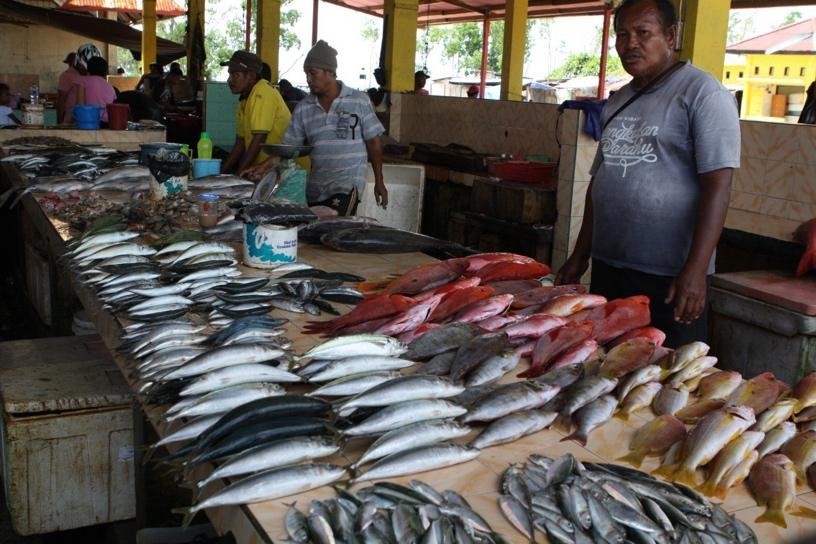Why Fish? Reasons, Challenges and Measures to Increase Fish Consumption in Indonesia
This article was published on marinetrends.id.
It is a usual sight to see fishers crowd the fish market in Kaimana Regency, West Papua Province, to offer their catch. They excitedly try to convince their customers to purchase and consume their fresh fish. Consumption of high quality fish is indeed one of many solutions to issues related to health such as stunting and severe malnutrition thanks to protein and micronutrient components in fish. Omega 3 in fish can prevent heart disease, stroke and high blood pressure. To grab these benefits, we must be more vigorous to increase fish consumption.
In Indonesia overall, fish consumption shows the increasing trend year by year, although not very high. In fact, fish consumption in Indonesia was low compared to other countries in Asia Pacific region, recorded at 12.78 kg/capita/year in 2011, lower than Cambodia (63.15 kg/capita/year) and Thailand (31.39 kg/capita/year).

Local fish market in Kaimana Regency, West Papua Province. Photo credit: Wiro Wirandi/Econusa
Low fish consumption in Indonesia can be driven by several factors. First, the infrastructure needed to distribute high quality fish to consumers is lacking. The infrastructures that are lacking include modern and accommodating infrastructure for markets, minimum supplies for ice, or few cold storages in the boat. Fresh fish commodities has a short shelf life period, if they are not properly treated from boat to plate by an effective value chain improvement, fish quality would decrease and eventually affect the fish consumption.
Second, certain types of fish with the best quality, such as tuna, shrimp, crabs, octopus and cuttlefish are most likely traded to international market. This has lowered our national consumption of high-quality fish. In fact, the majority of consumers in Indonesia are exposed to fish with medium to low quality.
Third, people’s preference to consume meat instead of fish. Based on the reference of the agrarian communities, the consumption of beef, chicken, egg and milk, is more preferred than the consumption of fish, despite the high protein it contains (52.7%), compared to beef (19.6%) and eggs & dairy product (23.2%).
Ways to increase fish consumption.
1. Improving infrastructure to enhance the quality and procurement of seafood commodities
Infrastructure, particularly cold storage, is key to achieve effective and efficient supply chain, which results in a more efficient exchange of fish commodities and the availability of high quality fish commodities for domestic consumers. Fish commodities have short shelf-life due to the demand for the commodities to be fresh, hence the quantity of cold storage must be increased. Adding the availability of cold storage for producers, particularly local communities and small-scale fishermen, will also allow them to directly sell their products to customers instead of middle men (middle men usually own cold storage to keep fish fresh longer) – hence adding producers’ revenue. Adding cold storage will also keep fish fresh longer from production to consumption across districts and provinces in Indonesia.
2. Enacting government regulation on sustainable fisheries practices to increase fish availability, sustainability and quality
Illegal fishing has contributed to lower availability, sustainability and quality of fish in the sea, which eventually impacts consumption. According to the Ministry of Marine Affairs and Fisheries, some seafood commodities with high economic values have been overfished, decreasing its numbers in the open seas. Even worse, fishers use illegal practices such as bombing or gillnets to catch fish and seafood in a large number. These unsustainable practices would lead to low quality of seafood commodities. The use of gillnets, for instance, is now being banned in most countries since it harms the fish and ruin its gills. This problem is exacerbated by the fact that high quality fish and seafood are prioritized for export, making domestic consumption of high-quality fish even more challenging.
To tackle this problem, the Ministry of Marine Affairs and Fisheries has issued the Ministerial Regulation No. 56 Year 2016 that regulates the catching of lobsters and crabs based on their spawning conditions and sizes. To support the implementation of this regulation, key relevant stakeholders such as local communities, local government and development partners need to develop local law enforcement strategies to monitor and act upon violations of the regulation. By addressing overfishing and illegal fishing issues, we can increase availability, sustainability, and quality of fish and seafood consumption in the future, including for domestic consumers.
3. Running awareness-raising campaign on fish consumption
Many actors are involved in increasing fish consumption at the household level. Currently, there are some campaigns, both at the national and subnational levels, that attempt to increase people’s awareness regarding fish consumption. For example, the “gemar makan ikan” (enjoy eating fish) movement is a program from the Ministry of Marine Affairs and Fisheries (MMAF).
One of the campaigns held at the subnational level is the Communal Fish-Eating Festival held at Raja Ampat regency to increase public awareness and interest in buying and eating fish. The festival has become an annual activity in Raja Ampat, where participants can eat fish for free. Furthermore, they build consumers’ perception of the quality of fish in the domestic market. Such campaigns can be run at a more massive scale to further improve people’s awareness on the importance of consuming fish and to demand for the availability of high quality fish in the domestic market.
Now, with the three measures above and a proper roadmap to improve domestic fish consumption, let’s hope Indonesia can record a higher consumption of fish.